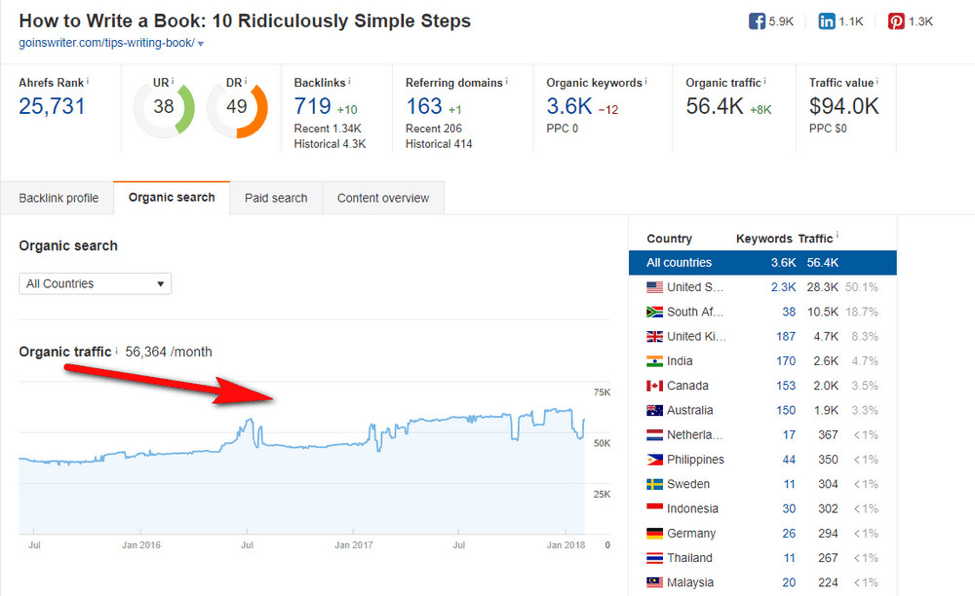Learn How You Can Update Old Blog Posts To Get Huge Traffic To Your Website

The world changes fast, and the Web is changing even faster. The content that seemed trendy and unique a few years or even months ago may appear outdated today. This can ultimately affect your rankings, your traffic, and visitors to your blog.
Why You Should Update Old Blog Posts
Google is highly targeted to please users, not the website owners. That’s why it shows the most relevant content for the topic on the first page and also boosts the freshest articles to the SERPs. The chances are, your well-researched, perfectly-written but old post may not even catch the eye of the user. Instead, they may click more fresh and updated articles of your competitors, which is why it may be worthwhile to update some of your old blog posts.
Another reason for continuously updating your blog and its content is that it can save time compared to writing a brand new blog post. To create a high-quality post from scratch, you need a few days (if not weeks) for researching, getting feedback from influencers, finding statistics and just writing it. Then you need to edit and proofread it, post it and set up some promotion on social media, emails and other channels.
But when you’re time-limited, updating older articles can be a real savior. You can quickly rewrite a few passages, add some fresh surveys and more precise stats, drop new photos – and you’re done.
What Content Should Be Updated
Updating old posts is easier than writing new ones, but it does indeed still require some time and effort on your end. So you should carefully examine your content and choose the pieces that are worth it and can bring you the best ROI.
Update the already well-performing posts
Start with checking Google Search Console and/or Google Analytics. You may notice that some posts bring you in quite a steady flow of traffic over an extended period of time. Usually, the curve on the graphs for these articles will be pretty straight or slightly fluctuating. Just take a look at the traffic curve for the post with book writing tips on Goinswriter.com:

It’s obvious that this post from 2012 gets (despite a couple of slight drops) a pretty stable amount of traffic through all the years. But if we check the post URL in Archive.org, we will also see that e.g., in 2014 it had a bit different title and content. The article has been updated a few times until it started getting that stable amount of traffic.
To take this further, this means you should pick the posts that already have a good potential for driving visits and shares. If they already attract an audience, the chances are they will experience a traffic spike after the update. Here are a few signs that a blog post is worth updating:
- The post already has a nice traffic flow. The stability of the flow matters more than the numbers here;
- The post has a decent number of backlinks. If users backlink to your post then it provides more potential;
- The post has a high number of shares. People love sharing things that have already proved to be popular. So they will gladly share a cool post that already has a bunch of shares and likes.
Update trending/seasonal posts
Check out Google Trends for the seasonal posts you have on your blog. Thus, you will notice the regular spikes of traffic for the searches of ‘christmas presents’ in December or the ‘super bowl’ at the beginning of February.
Despite such articles not showing a stable curve of traffic, you should definitely consider updating those seasonal posts (or write a few) and update them each year. Unlike evergreen topics, these posts require fewer updates of the content: sometimes it’s even enough to change the publishing date. But if you wish to get some more quality traffic, you should regularly revise the content: add new info, ideas, and freebies.
How to Update Articles Properly
Updating older posts is easier than it may seem. You can choose to update only the publishing date or the title, or the focus keyword. Your primary goal should be creating a better piece of content than it was before the update. Let’s check out the steps you can take to update your old blog posts and gain massive traffic from them.
Get Some New Keywords
If you feel you don’t get enough traffic for the article, you should review its keywords. Sometimes good articles don’t have enough traffic because of targeting wrong keywords.
Have you set any keywords for your article? Why do you think they are relevant and “good” for your content? Do you rank for the keywords you target? So, it will be great to research for some more keyword for your article. You can do it in a couple of steps:
- Check out the article you update in Google Search Console, MOZ or other related SEO ranking tools to find out what keywords it already ranks for;
- Check out those keywords in your favorite keyword tool. You can generate more keyword ideas with them and find new untapped keywords that can be a better solution for your post;
- Choose among keyword ideas those that have a good search volume, high traffic potential, but are easy to rank for. Long-tails are great types of keywords that can help you to rank for hundreds of keywords from just one or two root terms.
Review the Headline and the Text
If you’re trying to target other keywords than you targeted earlier, you might want to reconsider its headline. And even if you don’t, you might wish to review your headline and come up with a few fresh ideas for your article’s title.
Review the article parts and its overall structure: what are its weakest and strongest parts, what can be improved, what you should ditch, maybe change the order of the parts, etc. Add new graphs, charts, links to the latest relevant studies.
Proofread your article and correct all the mistakes, check out the spelling and grammar. Of course, spelling is not a ranking factor. However, it impacts the reader’s trust to the content, and thus tells Google that the content is relevant and worth attention.
Improve Your Meta-Data
Even if you don’t change your target keyword, you probably may wish to improve your meta-data a bit. Making your description more appealing may tempt more readers that will wish to click your link.
- Come up with a new title for your post. Ideally, you should create up to 5 versions of one title. WordPress users can install the Optimizely plugin. It allows doing some A/B testing on titles and choosing the most attractive one. Try to come up with a few variants to choose the most appropriate and catchy regarding readers’ clicks.
- Make your meta description more attractive and compelling. Ideally, this should describe what your page is about in a few short sentences. This could encourage user click-through-rate in the SERPs so don’t forget to work on it.
Warning! Whatever you do with your title and description, never change the URL of the article. Since crawlers already index the old article, changing the URL may mean losing traffic that the article already has.
Do More Internal Linking
Google considers internal linking as a significant factor of relevancy of the content. So consider internal linking between your best articles. They improve the users’ trust to your content and increases chances that users will click those links and read (bring some traffic) to other articles on your blog.
Change Posting Date
Despite the recommendation to not change the URL, it’s highly recommended to change the posting date to make it more fresh. There are many cases when updating the posting date alone have provided a huge boost in rankings for the article.
Promote Your Updated Article
So, you’re done with updating. But now you need to invest some more time into its promotion like you do with any newly published blog post.
- Post it again to social media accounts and add it to the Home page with a short note about the key updates.
- Include it in a broadcast email to your subscribers with a similar note about the content improvements you’ve done to it.
You can also do some outreach and ask other bloggers and influencers what they think about the update. But do it carefully: reach out to bloggers only in case you’ve made some significant update like new case studies and stats addition, rewrites from a new point of view and so on.
Combine some of these tips above and you’ll be well on your way to increased blog traffic!
Author bio:
 Helen is a content marketer at Ahrefs. She enjoys exploring new things every day to impress her readers with interesting & catchy stories. Apart from marketing, Helen loves listening to music, reading and traveling. A lot! You can follow Helen on Twitter and Facebook.
Helen is a content marketer at Ahrefs. She enjoys exploring new things every day to impress her readers with interesting & catchy stories. Apart from marketing, Helen loves listening to music, reading and traveling. A lot! You can follow Helen on Twitter and Facebook.
Any questions? Leave them in the comments section!

I have an old post written on webshosting, however I would like to update it to include information on the Best web hosting of 2018. Thank you for sharing these tips with us all
Hi there,
Thanks for the comment and I’m glad you received value from this post.
This is a great strategy, any questions on the steps above just let me know
~ Evan Hoeflich